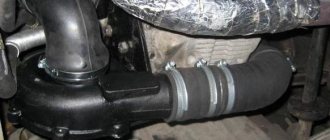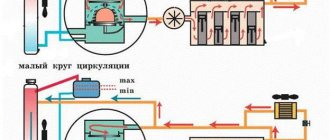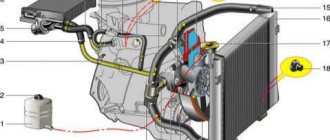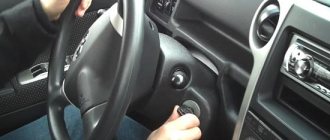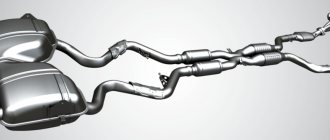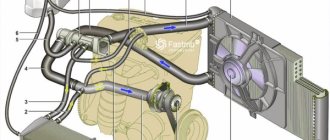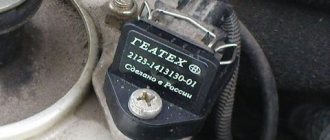| The engine cooling system (ECS) is one of the main systems of a car. The heater on the LADA Granta does not heat up or the engine does not warm up to the required temperature? Then the inspection should begin with this system. In this article you will find all the information on the operation of the Lada Granta cooling system . |
Design features of the LADA Granta engine cooling system
The LADA Granta engine cooling system is liquid (with forced circulation of liquid), sealed, with an expansion tank. The system is filled with ethylene glycol-based coolant (antifreeze), which does not freeze at ambient temperatures down to -40 'C.
The design of the cooling system of all engines installed on Lada Granta cars is fundamentally the same and is described using the example of a car with a VAZ-21116 engine.
Location of elements of the LADA Granta cooling system:
water pump provides forced circulation of fluid in the cooling system of the Lada Granta, is installed on the front plane of the cylinder block and is driven by a timing belt. The pump has sealed bearings that do not require replenishment of lubricant. The pump cannot be repaired; if it fails (liquid leakage or bearing damage), it is replaced as an assembly.
A thermostat with a solid heat-sensitive filler maintains normal operating coolant temperature and reduces engine warm-up time. The Lada Granta thermostat has a main and additional bypass valve. At a coolant temperature of up to (85±2) °C, the thermostat is completely closed and the liquid circulates through a small circuit, bypassing the radiator, which speeds up engine warming up. At temperatures above 85 C, the thermostat begins to open, and at 102 ° C it opens completely, allowing fluid to circulate through the radiator. An electric fan with a plastic impeller ensures that the radiator is purged with air at low vehicle speeds, mainly in urban conditions or on mountain roads, when the oncoming air flow is not enough to cool the radiator. To increase operating efficiency, the fan is installed in casing 7 and attached to it at three points through rubber pads. The casing, in turn, is attached to radiator 3 at four points. The electric fan is controlled by the engine control unit, which receives information about the coolant temperature from sensor 5 (see Fig. 1), located in thermostat socket 4.
The radiator is tubular-plate, aluminum, with plastic tanks, two-way, with a partition in the left tank. At the bottom right there is a drain plug 6. The tanks contain inlet and outlet hose pipes to the engine water jacket, as well as a hose pipe connecting the radiator to the expansion tank.
The expansion tank serves to compensate for the changing volume of coolant depending on its temperature. The tank is made of translucent plastic. The “MAX” and “MIN” marks are applied to its walls to control the coolant level; on top there is a filler neck, hermetically sealed with a plastic plug 1 with two valves inside (inlet and outlet), assembled in a single block. The exhaust valve opens at a pressure of 110 kPa (1.1 kgf/cm2), ensuring an increase in the boiling point of the coolant and preventing intense vaporization. When a liquid cools, its volume decreases and a vacuum is created in the system. The inlet valve in the plug opens at a vacuum of about 3 kPa (0.03 kgf/cm*) and allows air into the expansion tank.
As you know, when creating the Lada Grant, engineers and mechanics borrowed ideas for the embodiment of the car not only from the body part of the Lada Kalina, but also from the technical side as well.
For example, Grant’s car with the “Standard” package is equipped with a 1.6-liter Kalina engine with a capacity of 80 horsepower. The “Norma” and “Lux” packages have a modified engine with an increased piston stroke and an output power of 90 hp.
It is worth noting that these statistics are not only in numbers; in fact, the machine performs its performance at full strength. This is a fairly powerful characteristic for the domestic Lada Grant; the engine cooling system plays a vital role here.
Dashboard wiring
The electrical circuit of the instrument panel is the most complex, since it contains 34 devices. But you can figure it out too. Here is a list of available devices.
The instrument panel is a complex device
- The plug to which plug 9 of the front wiring is connected.
- Plug for connecting plugs 10 and 11 of the front wiring.
- The connector to which socket 1 of the rear wiring is connected.
- Connector for connecting socket 2 of the rear wiring.
- Control unit for dimensions, low beam, emergency lights.
- Mechanical ignition switch.
- Route bookmaker mode switch.
- Wiper switch.
- Dashboard.
- Light switch.
- Switch for the electric trunk lock.
- Diagnostic block.
- The connector to which the air intake box harness plug is connected.
- Rear window defroster switch.
- Emergency light switch.
- Brake light switch.
- Connector for connecting audio system speakers.
- The connector to which the car radio is connected.
- Device on the steering wheel.
- Driver's airbag module.
- Absent.
- Fuse block.
- Power steering (ESR).
- Cigarette lighter socket.
- Climate control console illumination lamp.
- Tidy light bulb.
- The socket to which the ignition system wiring plug is connected.
- Control device.
- Clutch pedal position indicator switch (only on cars with a manual gearbox).
- E-gas.
- Climate control system resistor.
- Electric motor for interior heater.
- Interior heater switch.
- Door lock control module.
The wiring diagrams for the Lada Granta ignition system vary depending on the type of engine installed, so when replacing the engine, the wiring of this system must also be changed.
The electrical circuits of the Lada Granta in the Standard and Liftback car versions are the same, but in the Lux car it has slight differences. Regardless of the vehicle variation, the negative terminal in the electrical circuit is always ground or ground. The wire must be connected to any bolt screwed into the car body.
System and main characteristics of electrical equipment Lada Granta
Design of the engine cooling system on Grant
The cooling system on Grant is liquid, closed type. The design involves forced distribution of coolant to all engine elements that need it. The fluid flow diverges evenly.
Despite some differences in Granta engines of various configurations, the cooling system works the same on all.
Let's look at the main elements of ODS on Grant:
Liquid pump.
The regular and uniform supply of antifreeze or antifreeze (coolant) to the heated engine elements depends on it.
The pump is located on the front surface of the cylinder block. As soon as the gas distribution mechanism is activated, under the action of the toothed belt, the water pump begins pumping fluid. The pump does not require lubrication, as it is equipped with closed bearings.
If it breaks down, the liquid pump cannot be repaired. For the continued functioning of all parts of the cooling system, the old pump must be replaced with a new one.
2. Thermostat.
Equipped with a solid heat-sensitive filling, which helps maintain the required coolant temperature.
When operating a vehicle, this system significantly reduces the time spent warming up the engine.
The thermostat design implies the presence of a main and additional bypass valve. If the coolant temperature does not exceed 85 degrees, the thermostat is closed, preventing fluid from moving through the radiator. Due to this, the time for warming up the engine is reduced. The thermostat directs fluid to the radiator at temperatures above 85 degrees.
Radiator and expansion tank
The radiator device is equipped with plastic tanks and hoses leading to the engine water jacket and expansion tank.
The radiator on Grant is manufactured by a French manufacturer. The design and operating principle of the device is similar to the performance of radiators installed on Renault Logan.
The expansion tank has the function of compensating and smoothing the amount of liquid evaporating due to temperature changes.
Electric fan.
Made of plastic and has the function of cooling the radiator with air flow.
Usually, the radiator is cooled by a natural, oncoming flow of air when the car is moving, but sometimes it happens that this is not enough.
Problems caused by malfunctions in the Lada Granta engine cooling system
In a Lada Granta car, the cooling system in the operating scheme is quite typical. Accordingly, the problems associated with it are often typical.
Let's look at some known problems associated with the Lada Granta ODS, as well as their possible solutions:
The engine gets very hot.
This problem can be caused by several reasons:
– there is not enough coolant in the system (needs to be added);
– the thermostat does not open (you need to buy and install a new thermostat);
– the pump does not function (the liquid pump needs to be replaced);
– the valves in the expansion tank are faulty (check, replace).
The heater in the car blows a cold stream of air.
This problem is often accompanied by engine overheating. Most likely it's a bad cylinder head gasket. This leads to coolant leakage and the formation of vapor locks in the cooling system.
To resolve the problem, it is necessary to replace the cylinder head gasket.
The engine takes a very long time to warm up.
The problem is most likely a faulty thermostat. When broken, it hangs in a closed or open state (in this case, open).
A new thermostat needs to be installed.
Rapid decrease in coolant level in the tank.
The problem can be caused by several reasons:
– leaky connection between the radiator and expansion tank (check for integrity and tightness of the connection);
– hoses are damaged (check integrity, replace);
– leakage through the cylinder head gasket (check, replace).
Fogging of windows, oil stains on the windshield, decreased coolant level.
These problems together indicate a leaky stove heater. It is necessary to check all connections from the radiator for leaks.
You should regularly flush the elements of the engine cooling system, otherwise the accumulation of dirt and dust will cause clogging of the installation, which will also lead to engine overheating or other problems.
We carry out diagnostics
If it is cold outside and the interior cannot warm up properly, then you need to check the operation of the cooling system, which has a direct effect on heating the interior.
Coolant level
To do this, you need to open the hood and, with the engine not warmed up, check where the coolant is located.
If its level in the tank is between the minimum and maximum marks, then everything is in order. But, when this level decreases, problems with the tightness of the cooling system are possible, and this leads to a decrease in pressure inside the system. If the problem is not corrected, the stove will not be able to warm the air in the cabin effectively enough.
Thermostat
This is a native Luzar thermostat
We are talking about the possible sticking of the thermostat valves in a position where the coolant circulates only in a larger circle. So, during the cold period, the coolant will not warm up to normal temperature, and therefore the interior will not become warmer.
Thermostat location under the hood
You can verify the presence of this particular breakdown by the fact that the car, while stuck in traffic jams, begins to overheat very quickly. In addition, when moving along the highway at a stable speed, the engine loses its temperature too quickly, if we talk about the cold season. However, even if these “symptoms” are not observed in your car, this does not mean that the thermostat is working properly. It is quite possible that its defect lies only in tangible problems with the interior heater.
For even more complex cases, you can check the pipes that connect to the heater radiator. Normally, one should be hot and the other just slightly warm. If the second of the pipes is very cold, this will indicate that the stove radiator in your car is clogged. It won't be easy to clean it. Most likely, you will have to completely remove the entire stove.
Is the absence of an engine temperature sensor a cost-saving measure?
An interesting point is the absence of an indicator on the instrument panel indicating the fluid temperature and engine condition. As the developers themselves say, this indicator does not correspond to the price category of the car and is too expensive for it.
The solution to the problem was to install a special light bulb on the panel, which lights up red in case of overheating. If the system is working properly, in this case, the fan automatically turns on, and the problem is resolved without driver intervention.
Despite everything, the Lada Granta, whose cooling system is very well thought out, works well and rarely causes breakdowns. This is a proven car, albeit of a budget class.
On cars of the Lada Granta family with an injector, a closed-type liquid cooling system is pre-installed. Antifreeze circulates through the system forcibly, performing two functions: removing excess heat and lubricating units.
The standard operating temperature of the cooling system is 94 – 99℃, regardless of the actual configuration of the car, body type, and other technical characteristics.
Why is overheating dangerous?
If the engine gets very hot, this can ultimately lead to dire consequences for the car owner. Overheating leads to increased wear of parts and components.
If the motor has been running for a short time at high temperatures, then there is nothing to be afraid of. Nothing will happen to him in 5 minutes. The reasons for this are various malfunctions with the fan or incorrect operation of the thermostat. If you stop the car in time, the maximum consequences are melting of the pistons. For a new car, short-term overheating is not at all scary.
If the engine operating temperature exceeds the norm for about 20 minutes or more, then there is a serious risk of cylinder head deformation and gasket burnout. Inter-ring partitions may also become unusable.
If the engine is completely overheated, this is a real disaster. This leads to damage to every part, every unit. The motor could even explode if the components were a little more reliable. If there is severe overheating, the piston group will certainly melt, and liquid metal will fall on the cylinders. This will make the piston stroke much harder, which means more wear. Also, engine diagnostics after overheating often reveals inevitable problems in the operation of the lubrication system. Overheated oil will not have its original properties, and rubbing vapors will destroy themselves. Pistons can puncture the cylinder head, and the crankshaft often breaks in two.
Elements of the Lada Granta cooling system
- stove heater radiators;
- electric pump;
- engine;
- throttle assembly;
- thermostat;
- antifreeze temperature sensor;
- overheat indicator;
- viscous fan drive coupling;
- fan;
- radiator cap;
- radiator;
- expansion tank cap;
- expansion tank;
- water pump;
- drain valve of the lower circuit.
And also, pipes of the Lada Granta cooling system, metal clamps - ties.
Thermostat
The cooling device on the Lada Grant is the main link in the chain. Performs the function of a valve that redirects the flow of antifreeze from a small to a large circle. When the operating temperature is below 94°, the thermostat is in the closed position. The liquid circulates in a small circle without “entering” the radiator.
Cooling system Lada Granta - 8 and 16 valves, with and without air conditioning
| Name | Peculiarity |
| The engine cooling system (hereinafter referred to as SOD) of the Lada Granta family is completely identical to the Lada Kalina | Heater radiator, single-pass, low resistance, aluminum, brazed, high efficiency |
| The radiator is built into a small circuit, unlike previous generations | |
| The thermostat has one valve, not two, as was previously the case | |
| The thermostat controls the flow of antifreeze through the radiator | |
| The interior heating system has been improved by removing more heat from the heater radiator | Increased flow of antifreeze through the radiator at a small circle of rotation |
| One-way passage pattern instead of two-way | |
| Aluminum pipes are flat instead of cylindrical | |
| Soldering is used at all stages of articulation | |
| No chance of airing | Changing the angle of inclination of the antifreeze supply/return lines |
| Improved aerodynamic performance | |
| Fine tuning of engine operating temperature | |
| Increased operational efficiency due to | Changes in ignition timing |
| Economical fuel consumption mode |
How to get to the repair site without risk to the engine?
Overheating usually occurs in hot weather or in traffic jams. It makes sense to wait until the evening to get to the repair site on your own without any problems: it will become cooler and the traffic will decrease. There are several life hacks that will increase your chances of getting to your destination without overheating the engine.
Turn the heater on to maximum. Your task is to remove as much heat as possible from the cooling system. The stove will take away the excess heat from the engine, but at the same time you risk boiling yourself.
Keep the revs to a minimum. We mean the minimum possible for normal movement. In this case, the load on the engine will be less, which means less heat will be generated during operation. On vehicles with a manual transmission, you can upshift earlier than usual. Cars with an automatic transmission usually have a manual mode: move the selector knob to it and control the ranges manually.
Checking the radiator for leaks
The diagnostic process is not at all complicated; we carry it out ourselves, and if you don’t have free time, visit a service station to have the work performed by professionals.
Checking the radiator from the engine compartment side
- We place the car within the perimeter of the repair area, on the inspection hole, and open the hood.
- From the engine compartment side, we inspect the surface of the radiator for drips and traces of antifreeze (antifreeze) leakage.
- We carry out similar actions from under the bottom of the car;
- We inspect the antifreeze supply/return lines, upper and lower circuits.
The most common places for depressurization: corners around the perimeter, joints, ties with clamps.
How to drain antifreeze from the cooling system of a Lada Granta
- The hood is open, the car engine has cooled down to a safe temperature so as not to damage the skin.
- We unscrew 6 screws from under the bottom and remove the oil pan protection.
- Unscrew the drain plug in the lower circuit of the radiator.
- At the same time, unscrew the drain plug on the wall of the cylinder block. We substitute the container.
Unscrew the plastic drain plug of the radiator tank
Note to the driver!
The Lada Granta version has 8 valves. Place the container for testing below the ignition module, under the cylinder block (nut at “13”).
In the Lada Granta 16-valve, we first dismantle the starter, since it prevents free access to the plug. If you do not remove the starter, antifreeze will flood the part, temporarily rendering it unusable.
- After the liquid is completely drained from the water jacket, screw in the drain plugs. Fill in new antifreeze in a volume of 7.5 liters to about or 8.0 liters to the recommended average level.
Preventing problems
Comprehensive testing of a cooling system is a rather complex and time-consuming task. Typically, wear, clogging, mechanical damage and other problems are identified during the inspection process. But the car owner should perform several simple operations to check this system before each trip:
with a cold engine, inspect the expansion tank, make sure there are no signs of leaks, check the coolant level (the norm is between the min and max marks); if the level is close to the minimum permissible or lower, add coolant of the same brand that was used before
In the absence of a compatible coolant, it is permissible to increase the level using distilled water, but you can fill no more than half a liter; Check the fluid level again with the engine warm by carefully and slowly unscrewing the expansion tank cap (it gets very hot!). If the fluid level drops below the minimum after starting the engine, this indicates a leak due to damage to the hoses or pipes.
It is unacceptable to add cold fluid when the engine is warm, or to start the engine after draining the fluid from the system! If the decrease in the liquid level in the tank is insignificant and is due not to leakage, but to evaporation, you should add distilled water rather than antifreeze; it is this that evaporates first, resulting in an increase in the density of the liquid. Care must be taken to ensure that no gasoline gets into the coolant.
If the coolant level is fine and there are no leaks, but the engine heats up excessively or, conversely, does not warm up when starting, a more detailed diagnosis of the cooling system is needed.
How to remove air from the cooling system of a Lada Granta
There are several effective ways to bleed air from the system.
Purge using a pump
Method No. 1
- We move the stove heater lever to the “Maximum” position (car interior). Be sure to follow basic safety measures and place wheel chocks under the rear wheels.
- Unscrew the valve cover, having first removed the decorative trim.
- Using a screwdriver, loosen the clamp on the throttle body fitting and remove the rubber pipe..
- Unscrew the cap on the expansion tank
- Through a gauze bandage, blow air through your mouth in the direction of the expansion tank.
It is important not to overdo it, as you can start a new portion of air again.
Method No. 2
- We warm up the car to 40 - 45°, turn off the engine.
- Unscrew the throttle clamp and remove the hose.
- If liquid leaks out of the hose, put it back on, otherwise wait until the air comes out.
- We assemble the structure in reverse order.
One time is not always enough to remove air. We repeat the procedure as necessary.
Method No. 3
- We drive the front wheels of the car onto a hill so that the highest point in the cooling system is the “plug”.
- We twist the cap on the expansion tank and the cap on the radiator.
- We start the engine, it runs at idle speed.
- We warm up the car to an operating temperature of 40 - 45°.
- As soon as the antifreeze level begins to decrease, we replenish the missing amount.
- We repeat the procedure until the maximum amount of plug comes out.
- Screw the lids on.
Air removal methods
If you observe on the dashboard that the operating temperature of the engine is constantly exceeded (100 degrees or more), follow a number of steps to identify the problem:
- examine the joints of the pipes, the water pump and the expansion tank for leaks;
- check the fluid level in the tank;
- make sure that the cabin heater is functioning properly;
- If the temperature sensor is installed outside the cylinder head, check the operation of the electric fan by closing the contacts.
Before bleeding the cooling system, it is necessary to eliminate all leaks, if any are found. A water pump seal that has lost its seal should be replaced (as a rule, together with the pump), hose clamps should be tightened, and so on. There is no point in removing an air lock from a leaking cooling system.
Checking the heater and fan sensor will help you more accurately determine the location of the air bubble. When the engine temperature reaches a critical threshold and the heater does not heat up, it means that the plug is in a small circulation circuit - in the stove itself or in the supply pipes. If the sensor does not turn on forced airflow in time, then it has entered an area where the movement of antifreeze has stopped - the bubble is in a large circuit.
Method one - blowing
This simplest method requires caution from the car enthusiast, since it is performed on a fully warmed-up engine. The order of operations is as follows:
- If necessary, add fluid to the minimum level and warm up the power unit to operating temperature. Carefully unscrew the cap of the expansion tank.
- Wear gloves and disconnect the thin coolant pipe at the highest point. For an engine with an injector, this is the throttle valve heating unit; on a carburetor engine, it is the intake manifold or the lower part of the carburetor itself.
- Wipe the reservoir neck thoroughly. Place a wide bowl under the removed hose and blow into the expansion tank. When clean antifreeze flows from the pipe, put it on the fitting and secure it with a clamp.
If your vehicle has a thermostatic main radiator cap, try removing the air lock through it. Open both plugs and blow into the neck of the expansion tank.
Method two - complete replacement
This option is suitable for all cases when it is not possible to detect and push a bubble out of pipelines. The point is to completely empty the system and fill it back with antifreeze, following all the rules. The disadvantage of the method is the difficulty of implementation in road conditions.
The procedure is performed in the following order:
- Drain the antifreeze into a wide basin, placing it alternately under the plug on the cylinder block and the main radiator.
- Replace all caps and tighten them.
- Loosen the clamp and remove the throttle body or carburetor heater pipe (the highest point of the system).
- Insert a funnel into the neck of the expansion tank and slowly pour coolant in a thin stream. Air will be removed through the removed hose.
- Monitor the moment when antifreeze runs out of the pipe and immediately put it on the fitting.
Before emptying, be sure to fully open the cabin heater tap.
When the throttle (or carburetor) heating hose is put on and secured with a clamp, add fluid to the container to the required level. Next, check the functionality of the cooling by completely warming up the engine until the thermostat opens and the electric fan turns on.
Method three - road
When faced with overheating of the power unit on the road, try to remove the airlock using this method:
- Having secured the car with the handbrake, lift the front part with a jack to a height of 0.3–0.4 m.
- Slowly unscrew the expansion tank cap, start the engine and turn on the cabin heater to maximum mode.
- Pour antifreeze into the tank in a thin stream until its level reaches the upper limit. Increase the crankshaft speed to 3000 rpm and wait until it warms up completely.
- Squeeze the lower hose leading to the radiator with your hand. The air should escape through the expansion tank. Use gloves or thick cloth to avoid getting burned.
The procedure ends when air stops coming out of the tank. Feel the remaining pipes - they should warm up. Make sure the stove produces a hot stream.
To avoid having to fuss with removing air pockets, always fill in antifreeze according to the instructions described in the previous section. This is the best way to force air out of the system. Fix leaks in a timely manner, do not drive with endless additions of coolant.
How to flush the cooling system on a Lada Grant
Violation of the deadlines for replacing the fluid, the purchase of cheap analogues contributes to the formation of sediment in the line and clouding of the antifreeze.
Due to the loss of chemical and physical properties, the water jacket of the power unit is subject to corrosion and peeling.
A constantly elevated operating temperature is the first sign of contamination, deposit formation, or thermostat malfunction. The manufacturer recommends cleaning the lines every 50,000 km. Replacement of antifreeze after 75,000 km.
The volume of the Lada Granta cooling system is 8.0 liters.
Cleaning methods
- external;
- internal.
In the first case, all dirt is removed from the outside using water pressure and adding detergent. In the second case, washing is carried out inside with special chemicals.
If the flushing does not give a positive result, then we replace the standard radiator with a new one, since an excess amount of fossils has accumulated at the bottom and the corrosion process has begun.
Distilled water
There are several ways to get distilled water:
- buy at a pharmacy;
- melt clean snow;
- let tap water stand for six months.
The washing process is as follows:
- We place the car on the inspection channel, unscrew the fastenings of the oil pan protection.
- We twist the drain plug of the system and grind off the antifreeze. First, unscrew the cap from the expansion tank and relieve pressure.
- After the waste has been drained, tighten the plug and pour 8.0 liters of distilled water into the system.
- We start the engine, run it at medium speed for several minutes, and turn it off.
- We repeat steps 2 and 3. As soon as the water comes out with a pure color, the washing is complete.
- Refill with new antifreeze. Next replacement after 75,000 km.
Soda, acid and vinegar
Mix the indicated ingredients in the percentage ratio: 25 / 50 / 25, add a liter of water. We drain a similar volume from the system, add the “potion”, leave the car motionless for 6 – 8 hours, preferably overnight.
In the morning we grind off the waste, rinse the system once, and fill in clean antifreeze.
Special means
The process is similar to the one described above. We carry out in compliance with basic safety rules. You can purchase additives at any specialized auto store or car market.
Typical malfunctions of the Lada Granta cooling system
| Malfunction | Diagnostics | Remedy |
| The fluid level is below the permissible norm in the radiator | Inspection of the highway for integrity | Topping up |
| The motor is overheating | Thermostat is stuck | Replacement with new one |
| No pressure in the cooling system of Lada Granta | Channel clogging, depressurization | Replacing the water pump |
| The electric fan does not turn on when the temperature limit is reached | Checking the integrity of the electrical circuit and fuse |
Checking the Lada Granta fan circuit
What to do
What to do if the engine overheats
As soon as you notice that the engine has begun to overheat and the sensor is already entering the red zone, the best option is to turn off the engine. If you are on the move, then you should turn on neutral and roll until you come to a complete stop (with the emergency lights on), no loads, do not touch the gas pedal.
If the fluid level is fine, then there is a failure of the fan, thermostat, or something has gotten into the system. You can open the entire perimeter, that is, turn on the stove for maximum heating of the interior. The fluid temperature should drop, after which we calmly turn off the car.
If there is almost no fluid at all, you just noticed, then there is no option, turn off the engine immediately. This is a case of damage to the engine, either the oil drain or the radiator. The car will only be transported to service via a tow truck.
What the professionals advise is to keep an eye on your car and check the coolant level. If the antifreeze is normal, then even the failure of the fan will not be fatal; you can always help reduce the temperature with the stove.
Reviews
| Prevention, replacement with new ones | ||
| Whistle from under the expansion tank cap | Inspection | Replacement |
| The motor takes a long time to reach operating temperature | Inspecting the antifreeze level | Adding fluid, replacing the thermostat with a new one |
| The temperature sensor systematically shows false data | Inspecting the electrical circuit, measuring the sensor resistance | Replacement with new one |
| No circulation in the main line | Inspection through the expansion tank with the engine running | Washing, removing air pockets |
| № | Positive |
| 1. | Vasily: I’ve been driving a car for a year and a half, no comments. I carry out technical inspections in a timely manner, fill up with high-quality fuel and oils, and have a moderate driving style. |
| 2. | Gennady: at 50,000 km the standard thermostat jammed, replaced it with a new one under warranty. There were no more breakdowns, the machine works like a watch. |
| 3. | Kirill: the rubber pipe burst once where it was fixed with a clamp, I think it was my mistake, I overtightened it. I'm happy with the build quality, no complaints. |
| 4. | Vladlen: I’ve heard negative reviews about Granta, saying that the system is often overstuffed. This happens, but extremely rarely, the defect is not widespread. |
| 5. | Ignat: in order for the machine to work properly and the parts to last longer, it is necessary to treat it with care, care for it, and maintain it. |
| 6. | Dmitry: Six months have passed since the purchase of the car, so far the work is perfect, no investments except for the purchase of consumables. |
| 7. | Valentin: I am satisfied with the build quality of domestic transport; breakdowns do occur, but they are insignificant and can be easily repaired. The engineers managed to combine good quality at an affordable price. |
| Negative | |
| 1. | Ivan: negative experience during operation of the car, already at 45,000 the thermostat jammed, then the bearing flew off. The model is still crude, there are many shortcomings, the manufacturer does not strive to quickly eliminate them. |
| 2. | Vladimir: the build quality is low, after two months of using the car, the rubber pipe cracked and antifreeze began to leak. |
| 3. | Vyacheslav: Lada Granta or Renault Logan - obviously the latter. The manufacturing quality of the French automobile industry is an order of magnitude higher than its domestic counterpart. |
Conclusion As practice shows, most calls to service stations are caused by a jammed thermostat on the Lada Grant. The reasons are different. The factor of manufacturing defects cannot be ruled out, but the fault also lies with the owner of the car.
Buy original spare parts, maintain your car in a timely manner - then the number of breakdowns will be reduced several times.
Recommendations for the selection of parts and components
The range is represented by domestic manufacturers, originals and high-quality analogues. The final choice is up to the owner of the technical device.
Service center technicians strongly recommend purchasing original parts. The service life and manufacturing quality of factory components are an order of magnitude higher than their analogues.
Before purchasing, carefully check the spare part catalog numbers with the actual data in the instruction manual. If necessary, get free consultations from service station specialists.
Lately it has become popular to order parts for subsequent installation directly in workshops. There are many advantages of this choice: prompt delivery, professional installation, quality guarantee.


